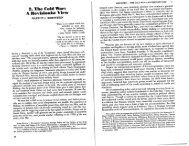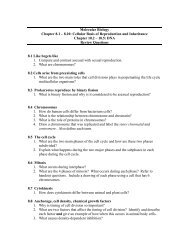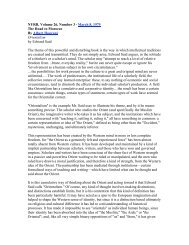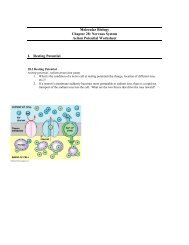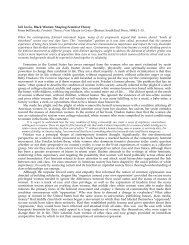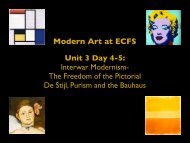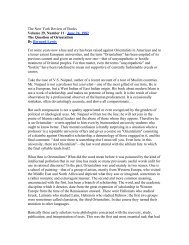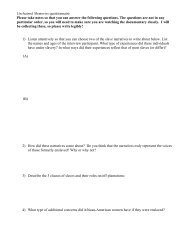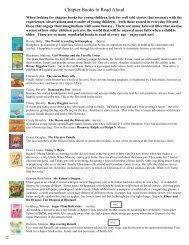Howard Zinn: Columbus, the Indians, andHuman ProgressArawak men and women, naked, tawny, and full of wonder,emerged from their villages onto the island’s beaches andswam out to get a closer look at the strange big boat. WhenColumbus and his sailors came ashore, carrying swords,speaking oddly, the Arawaks ran to greet them, brought themfood, water, gifts. He later wrote of this in his log:They . . . brought us parrots and balls of cotton and spears and manyother things, which they exchanged for the glass beads and hawks’bells. They willingly traded everything they owned.... They werewell-built, with good bodies and handsome features. . . . They donot bear arms, and do not know them, for I showed them a sword,they took it by the edge and cut themselves out of ignorance. Theyhave no iron. Their spears are made of cane. They would make fineservants. With fifty men we could subjugate them all and makethem do whatever we want.These Arawaks of the Bahama Islands were much like Indianson the mainland, who were remarkable (Europeans observerswere to say again and again) for their hospitality, their beliefin sharing. These traits did not stand out in the Europe ofthe Renaissance, dominated as it was by the religion of popes,the government of kings, the frenzy for money that markedWestern civilization and its first messenger to the Americas,Christopher Columbus.Columbus wrote:As soon as I arrived in the Indies, on the first Island which Ifound, I took some of the natives by force in order that theymight learn and might give me information of whatever thereis in these parts.The information that Columbus wanted most was: Where isthe gold? He had persuaded the king and queen of Spain tofinance an expedition to the lands, the wealth, he expectedwould be on the other side of the Atlantic--the Indies and Asia,gold and spices. For, like other informed people of his time, heknew the world was round and he could sail west in order toget to the Far East.Spain was recently unified, one of the new modern nation-states,like France, England, and Portugal. Its population, mostlypoor peasants, worked for the nobility, who were 2 percent ofthe population and owned 95 percent of the land. Spain hadtied itself to the Catholic Church, expelled all the Jews, drivenout the Moors. Like other states of the modern world, Spainsought gold, which was becoming the new mark of wealth,more useful than land because it could buy anything.There was gold in Asia, it was thought, and certainly silks andspices, for Marco Polo and others had brought back marvelousthings from their overland expeditions centuries before. Nowthat the Turks had conquered Constantinople and the easternMediterranean, and controlled the land routes to Asia, a searoute was needed. Portuguese sailors were working their wayaround the southern tip of Africa. Spain decided to gamble ona long sail across an unknown ocean.In return for bringing back gold and spices, they promisedColumbus 10 percent of the profits, governorship over newfoundlands, and the fame that would go with a new title:Admiral of the Ocean Sea. He was a merchant’s clerk fromthe Italian city of Genoa, part-time weaver (the son of a skilledweaver), and expert sailor. He set out with three sailing ships,the largest of which was the Santa Maria. perhaps 100 feetlong, and thirty-nine crew members.Columbus would never have made it to Asia, which wasthousands of miles farther away than he had calculated,imagining a smaller world. He would have been doomed bythat great expanse of sea. But he was lucky. One-fourth of theway there he came upon an unknown, uncharted land that laybetween Europe and Asia--thc Americas. It was early October1492, and thirty-three days since he and his crew had left theCanary Islands, off the Atlantic coast of Africa. Now they sawbranches and sticks floating in the water. They saw flocks ofbirds. These were signs of land. Then, on October 12, a sailorcalled Rodrigo saw the early morning moon shining on whitesands, and cried out. It was an island in the Bahamas, theCaribbean sea. The first man to sight land was supposed toget a yearly pension of 10,000 maravedis for life, but Rodrigonever got it. Columbus claimed he had seen a light the eveningbefore. He got the reward.So, approaching land, they were met by the Arawak Indians,who swam out to greet them. The Arawaks lived in villagecommunes, had a developed agriculture of corn, yams, cassava.They could spin and weave, but they had no horses or workanimals. They had no iron, but they wore tiny gold ornamentsin their ears.This was to have enormous consequences: it led Columbus totake some of them aboard ship as prisoners because he insistedthat they guide him to the source of the gold. He then sailedto what is now Cuba, then to Hispaniola (the island whichtoday consists of Haiti and the Dominican Republic). There,bits of visible gold in the rivers, and a gold mask presented toColumbus by a local Indian chief, led to wild visions of goldfields.On Hispaniola, out of timbers from the Santa Maria, whichhad run aground, Columbus built a fort, the first Europeanmilitary base in the Western Hemisphere. He called it Navidad(Christmas) and left thirty-nine crewmembers there, withinstructions to find and store the gold. He took more IndianPrisoners and put them aboard his two remaining ships. Atone part of the island he got into a fight with Indians whorefused to trade as many bows and arrows as he and his menwanted. Two were run through with swords and bled to death.79
Then the Nina and the Pinta set sail for the Azores and Spain.When the weather turned cold, the Indian prisoners began to die.Columbus’s report to the Court in Madrid was extravagant.He insisted he had reached Asia (it was Cuba) and an islandoff the coast of China (Hispaniola). His descriptions were partfact, part fiction:Hispaniola is a miracle. Mountains and hills, plains andpastures, are both fertile and beautiful, the harbors areunbelievably good and there are many wide rivers of which themajority contain gold. . . . There are many spices, and greatmines of gold and other metals.The Indians, Columbus reported, “are so naive and so freewith their Possessions that no one who has not witnessed themwould believe it. When you ask for something they have, theynever say no. To the contrary, they offer to share with anyone.. ..“ He concluded his report by asking for a little help from theirMajesties, and in return he would bring them from his nextvoyage “as much gold as they need and as many slaves as theyask.” He was full of religious talk: “Thus the eternal God, ourLord, gives victory to those who follow His way over apparentimpossibilities.”Because of Columbus’s exaggerated report and promises, hisSecond expedition was given seventeen ships and more thantwelve hundred men. The aim was clear: slaves and gold. Theywent from island to island in the Caribbean, taking Indiansas captives. But as word spread of the Europeans’ intent theyfound more and more empty villages. On Haiti, they foundthat the sailors left behind at Fort Navidad had been killed ina battle with the Indians, after they had roamed the island ingangs looking for gold, taking women and children as slavesfor sex and labor.Now, from his base on Haiti, Columbus sent expedition afterexpedition into the interior. They found no gold fields, buthad to fill up the ships returning to Spain with some kindof dividend. In the year 1495, they went on a great slave raid,rounded up fifteen hundred Anawak men, women, and children,put them in pens guarded by Spaniards and dogs, then pickedthe five hundred best specimens to load onto ships. Of thosefive hundred, two hundred died en route. The rest arrived alivein Spain and were put up for sail by the archdeacon of the town,who reported that, although the slaves were “naked as the daythey were born,” they showed “no more embarrassment thananimals. Columbus later wrote: “Let us in the name of theHoly Trinity go on sending all the slaves that can be sold.”But too many of the slaves died in captivity. And so Columbus,desperate to pay back dividends to those who had invested, hadto make good his promise to fill the ships with gold. In theprovince of Cicao on Haiti, where he and his men imaginedhuge gold fields to exist, they ordered all persons fourteenyears or older to collect a certain quantity of gold every threemonths. When they brought it, they were given copper tokensto hang around their necks. Indians found without a coppertoken had their hands cut off and bled to death.The Indians had been given an impossible task. The only goldaround was bits of dust garnered from the streams. So theyfled, were hunted down with dogs, and were killed.Trying to put together an army of resistance, the Arawaks facedSpaniards who had armor, muskets, swords, horses. When theSpaniards took prisoners they hanged them or burned them todeath. Among the Arawaks, mass suicides began, with cassavapoison. Infants were killed to save them from the Spaniards.In two years, through murder, mutilation, or suicide, half ofthe 250,000 Indians on Haiti were dead.When it became clear that there was no gold left, the Indianswere taken as slave labor on huge estates, known later asencomiendas. They were worked at a ferocious pace, and diedby the thousands.By the year 1515, there were perhaps fifty thousand Indiansleft. By 1550, there were five hundred. A report of the year1650 shows none of the original Arawaks or their descendantsleft on the island.The chief source and, on many matters the only sourceof information about what happened on the islands afterColumbus came is Bartolome de las Casas, who, as a youngpriest, participated in the conquest of Cuba. For a time heowned a plantation on which Indian slaves worked, but he gavethat up and became a vehement critic of Spanish cruelty. LasCasas transcribed Columbus’s journal and, in his fifties, begana multi-<strong>volume</strong> History of the Indies. In it he describes theIndians. They are agile, he says, and can swim long distances,especially the women. They are not completely peaceful,because they do battle from time to time with other tribes,but their casualties seem small, and they fight when they areindividually moved to do so because of some grievance, not onthe Orders of captains or kings.Women in Indian society were treated so well as to startle theSpaniards Las Casas describes sex relations:Marriage laws are non-existent: men and women alikechoose their mates and leave them as they please withoutoffense, jealousy or anger. They multiply in great abundance,pregnant women work to the last minute and give birth almostpainlessly; up the next day, they bathe in the river and are asclean and healthy as before giving birth. If they tire of theirmen, they give themselves abortions with herbs that forcestillbirths, covering their shameful parts with leaves or cottoncloth; although on the whole, Indian men and women lookupon total nakedness with as much casualness as we look upona man’s head or at his hands.The Indians, Las Casas says, have no religion, at least notemples. They live in large communal bell-shaped buildings,housing up to 600 people at one time ... made of very strongwood and roofed with palm leaves.... They prize bird feathersof various colors, beads made of fishbones, and green and whiteStones with which they adorn their ears and lips, but theyput no value on gold and other precious things. They lack allmanner of commerce, neither buying nor selling, and relyexclusively on their natural environment for maintenance.They are extremely generous with their possessions and by the80 <strong>fieldston</strong> <strong>american</strong> <strong>reader</strong> <strong>volume</strong> i – <strong>fall</strong> <strong>2007</strong>
- Page 4 and 5:
the federalist papers #51 (1787)...
- Page 6 and 7:
Inventing An AmericaCrèvecoeur Dis
- Page 8 and 9:
I say to you today, my friends, tha
- Page 10 and 11:
melodies of the Negro slave; the Am
- Page 12 and 13:
31.the encounterand north americasu
- Page 14 and 15:
Native American PoetryWHEN SUN CAME
- Page 16 and 17:
Pagans and Pilgrims in the Promised
- Page 18 and 19:
Reverend Doctor Sepulveda has spoke
- Page 20 and 21:
Juan Gines de Sepulveda:“The Grea
- Page 22 and 23:
Nathaniel Bacon: Bacon’s Declarat
- Page 24 and 25:
The sale of human beings in the mar
- Page 26 and 27:
seeking great things for ourselves
- Page 28 and 29:
Therefore, let every one that is ou
- Page 30 and 31: frontier village she revised her ea
- Page 32 and 33: Edward Taylor: Poems (1642—I729)L
- Page 34 and 35: The Mayflower CompactNovember 11, 1
- Page 36 and 37: fly kites and shoot marbles, and to
- Page 38 and 39: Dominie Van Shaick, the village par
- Page 40 and 41: another man. In the midst of his be
- Page 42 and 43: Washington Irving:The Legend of Sle
- Page 44 and 45: a kind of idle gentlemanlike person
- Page 46 and 47: Tassel. In this enterprise, however
- Page 48 and 49: on the top of his nose, for so his
- Page 50 and 51: however, turned upon the favorite s
- Page 52 and 53: the green knoll on which stands the
- Page 54 and 55: so any nation, that discovers an un
- Page 56 and 57: indefatigable measures, the cause o
- Page 58 and 59: their heads on their shoulders inst
- Page 60 and 61: Metacomet Cries Out for RevengeIn t
- Page 62 and 63: Gustavus Vassa: The Interesting Nar
- Page 64 and 65: duct, and guard them from evil. The
- Page 66 and 67: particularly at full moons; general
- Page 68 and 69: that might come upon us; for they s
- Page 70 and 71: size of the finger nail. I was sold
- Page 72 and 73: intolerably loathsome, that it was
- Page 74 and 75: as he instinctively guessed its app
- Page 76 and 77: Document DSource: Articles of Agree
- Page 78 and 79: Next to manners are the exterior gr
- Page 82 and 83: same token covet the possessions of
- Page 84 and 85: and culture, to ensnare ordinary pe
- Page 86 and 87: Fire Brand, and putting it into the
- Page 88 and 89: included the Mohawks (People Of the
- Page 90 and 91: It has been tempting to dismiss Jef
- Page 92 and 93: she found herself back in prison. M
- Page 94 and 95: 311.the struggle forindependence176
- Page 96 and 97: John Locke: of Civil Government (16
- Page 98 and 99: Daniel Dulany: “Considerations”
- Page 100 and 101: First Continental Congress, Declara
- Page 102 and 103: colonies enabled her to triumph ove
- Page 104 and 105: and America is a strong and natural
- Page 106 and 107: considerable pecuniary resources, b
- Page 108 and 109: He has combined with others to subj
- Page 110 and 111: Mary Beth Norton:Women in the Revol
- Page 112 and 113: testified, so “I was obliged to S
- Page 114 and 115: peace terms. And, tragically, Samue
- Page 116 and 117: not that this glorious threesome ne
- Page 118 and 119: less powerful than the rest, as it
- Page 120 and 121: paramount culture, but to many for
- Page 122 and 123: James Kirby Martin: Protest and Def
- Page 124 and 125: 3111.developing a frameworkfor gove
- Page 126 and 127: The Articles of Confederation (1777
- Page 128 and 129: 7. Whenever the Confederate Lords s
- Page 130 and 131:
Darkness there, and nothing more.De
- Page 132 and 133:
Edgar Allen Poe:The Fall of the Hou
- Page 134 and 135:
of unnatural sensations. Some of th
- Page 136 and 137:
the full extent, or the earnest aba
- Page 138 and 139:
paused; for it appeared to me (alth
- Page 140 and 141:
Walt Whitman:Poetry Crossing Brookl
- Page 142 and 143:
101 Flow on, river! flow with the f
- Page 144 and 145:
41 Nor any more youth or age than t
- Page 146 and 147:
136 I am not an earth nor an adjunc
- Page 148 and 149:
13225 The negro holds firmly the re
- Page 150 and 151:
322 Patriarchs sit at supper with s
- Page 152 and 153:
415 And if each and all be aware I
- Page 154 and 155:
511 Voices of cycles of preparation
- Page 156 and 157:
27611 To be in any form, what is th
- Page 158 and 159:
702 Head high in the forehead, wide
- Page 160 and 161:
806 I go hunting polar furs and the
- Page 162 and 163:
908 Ten o’clock at night, the ful
- Page 164 and 165:
1001 I do not ask who you are, that
- Page 166 and 167:
1099 Believing I shall come again u
- Page 168 and 169:
1200 The great Camerado, the lover
- Page 170 and 171:
1294 And as to you Corpse I think y
- Page 172 and 173:
James Madison:The Federalist Papers
- Page 174 and 175:
James Madison:The Federalist Papers
- Page 176 and 177:
people are impliedly and incidental
- Page 178 and 179:
sort of people, who are orderly and
- Page 180 and 181:
Charles Beard: The ConstitutionA Mi
- Page 182 and 183:
Legislatures reflect these interest
- Page 184 and 185:
Staughton Lynd:The Conflict Over Sl
- Page 186 and 187:
France is an example. Jefferson had
- Page 188 and 189:
to the interior & landed interest,
- Page 190 and 191:
The first was to solve the problem
- Page 192 and 193:
there against mobs, demagogues, and
- Page 194 and 195:
3iv.the early republic: forging ana
- Page 196 and 197:
Alexander Hamilton and Thomas Jeffe
- Page 198 and 199:
employment to industrious individua
- Page 200 and 201:
Hamiltonian Federalists and Jeffers
- Page 202 and 203:
“As the present crisis of human a
- Page 204 and 205:
The Kentucky Resolutions of 1799The
- Page 206 and 207:
Washington’s Farewell Address,Sep
- Page 208 and 209:
equal law must protect, and to viol
- Page 210 and 211:
I sec.8, Congress has also been gra
- Page 212 and 213:
That the following amendments of th
- Page 214 and 215:
3v.the disgusting spirit ofequality
- Page 216 and 217:
Transcendentalism DefinedThough clo
- Page 218 and 219:
All are needed by each one;Nothing
- Page 220 and 221:
a long period continue, to rule is
- Page 222 and 223:
The broadest and most prevalent err
- Page 224 and 225:
clergyman whose preaching my father
- Page 226 and 227:
difference between resisting this a
- Page 228 and 229:
similar concern for the conditions
- Page 230 and 231:
few years I have been gravely disap
- Page 232 and 233:
In the midst of blatant injustices
- Page 234 and 235:
about the baby, whom she had hardly
- Page 236 and 237:
who, with conjugal affections and m
- Page 238 and 239:
a hut, tranquil, if in a crowd. The
- Page 240 and 241:
South Carolina Ordinance of Nullifi
- Page 242 and 243:
operation....The right to secede is
- Page 244 and 245:
Worcester v. Georgia and refused to
- Page 246 and 247:
effect in point of possession when
- Page 248 and 249:
hold the writer maintained with the
- Page 250 and 251:
986A narrow Fellow in the GrassOcca
- Page 252 and 253:
house.“You done talk too much wid
- Page 254 and 255:
Kate Chopin: The StormIThe leaves w
- Page 256 and 257:
IVAlcée Laballière wrote to his w
- Page 258 and 259:
When the letter reached Desiree she
- Page 260 and 261:
Her lip was beginning to tremble, a
- Page 262 and 263:
IIITheir eyes met, and she blushed
- Page 264 and 265:
een reversed.“Why, how do you do?
- Page 266 and 267:
of a juggler tossing knives; but th
- Page 268 and 269:
Having deprived her of this first r
- Page 270 and 271:
Sojorner Truth: Ain’t I A Woman?S
- Page 272 and 273:
Viewpoints of the Mexican WarThe fo
- Page 274 and 275:
evolt and sin...”Caleb Atwater, E
- Page 276 and 277:
encouraged this ideal of the perfec
- Page 278 and 279:
its own territory, with boundaries
- Page 280 and 281:
3vi.slavery, sectionalismand secess
- Page 282 and 283:
Charles W. Chestnut:The Passing of
- Page 284 and 285:
promptness and decision. “He’s
- Page 286 and 287:
left the hotel when a long‐haired
- Page 288 and 289:
and sent to the penitentiary. I tho
- Page 290 and 291:
Necessary Evil to Positive GoodSour
- Page 292 and 293:
Dred Scott vs Sanford (1857)The fol
- Page 294 and 295:
The Lincoln-Douglas Debates (1858)I
- Page 296 and 297:
DBQ: Free Soil, Free Labor, Free Me
- Page 298 and 299:
of the slave-holding system is to d
- Page 300 and 301:
“Why, not a cruel man, exactly, b
- Page 302 and 303:
Lincoln Denies Racial EqualityInter
- Page 304 and 305:
through an unseen multitude.“Ther
- Page 306 and 307:
that they intercepted, even for a m
- Page 308 and 309:
earded elders of the church have wh
- Page 310 and 311:
speak of. What! I have authority, I
- Page 312 and 313:
nothing to be shunned in the handso
- Page 314 and 315:
summer sun, it was his father’s c
- Page 316 and 317:
a human form appeared at intervals,



